From the Dean's Desk -- September 26, 2013
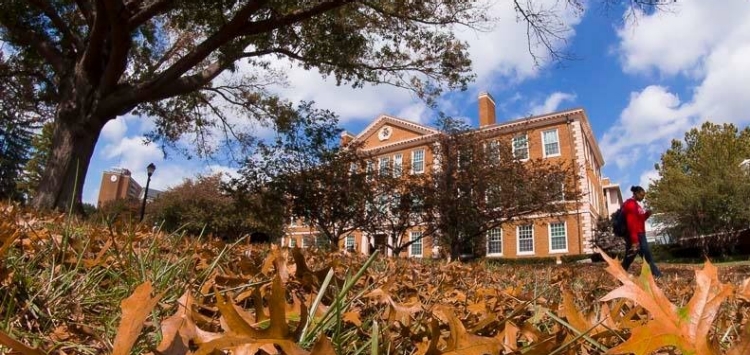
Good day to you. With the autumnal equinox this week, we formally welcomed fall and cooler temperatures on campus. Fall, from an academic perspective, begins about 5 weeks earlier and is a re-awakening of the spirit of exploration within the College of Science and Technology. This is especially true as we learn more about the activities undertaken during summer months by our faculty and staff as well as with the excitement generated from our new freshmen and outreach program. Many facets of student engagement and outreach outside the classroom are explored in this edition of our newsletter. We hope that you will be as impressed as we are with the activities of so many members of our community.
In this edition:
Museum of the Earth Sciences Welcomes 20,000th visitor
Upcoming Museum of the Earth Sciences Lectures
New Science In Action Undergraduate Research Video Highlights an International Experience
Mathematics and Dance Student Completes Internship at the Oak Ridge National Laboratory
Radford University Student Presents Research Project Regarding Bezout’s Theorem at Mathfest 2013 in Hartford,CT
Radford University Student Explores 14 Million Year Old Whale Fossils Near Richmond Virginia
College of Science and Technology Career Updates
Science Days Provide Support to Local Educators
College of Science and Technology Club and Organization Activity
Anthropology Lecture Series: Domestication of the Dog
National Chemistry Week - October 20-26
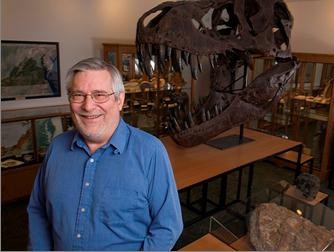
Dr. Steve Lenhart, Founder and Director of the Museum of the Earth Sciences
Museum of the Earth Sciences Welcomes 20,000th visitor
On Thursday, September 12, 2013, during the first “Science Day” outreach program for the 2013-2014 academic year, visitor number 20,000 entered the Museum of the Earth Sciences in Curie Hall. This milestone was made possible through the work of many RU faculty and staff members, students, and community volunteers who have helped move the museum to this point, but none more so than Dr. Steve Lenhart whose herculean efforts over the past 8 years have proven to be quite successful.
The Museum began as an idea to enhance the classroom activities for Radford University students and to help serve the science needs of the larger community. Today, the Radford University Museum of the Earth Sciences serves as an educational resource for earth science-related themes to the university, to the local K-12 communities, and to the public at large by encompassing the earth science-related fields of geology, meteorology, oceanography, planetary astronomy and physical anthropology.
Visitors to the museum are given the chance to grow their appreciation for our planet through many displays ranging from “stones to bones.” “The Radford University Museum of the Earth Sciences is a teaching museum” says Dr. Lenhart. “It recognizes that a critical component of learning about the physical earth is to have the visual and tactile access to actual specimens that only a museum allows. The Museum is not a static, dust-gathering collection of rocks and other geological specimens,” states Dr. Lenhart. “Rather, it is envisioned as a dynamic functioning center of quality exhibits with outreach and in-reach programs at all levels of learning and as a fascinating place in which to spend one’s time.” 20,000 visitors and counting would agree.
Most of the exhibits in the museum are self-guided, while a few displays are enhanced by the student and community docents who help create a context for the experience. “Considering the museum doesn’t have enough volunteer staff to keep the museum open year-round, 40 hours per week along with weekends, we have nonetheless been quite proud of its ever-growing popularity” states Dr. Lenhart. “Hopefully, additional volunteers in the future will allow for more open hours and result in even more visitors. Of course, the new museum facility in the new Center for the Sciences Building will allow for a more appropriately designed educational space providing more space for displays."
The Museum of the Earth Sciences will have a new, more prominent home as one of the anchors of the Main Street Level of the Center for the Sciences when that facility opens in 2015. With greater visibility, the Museum will likely experience a significant increase in the number of visitors as residents of the University Community and the region become more aware of this outstanding resource.
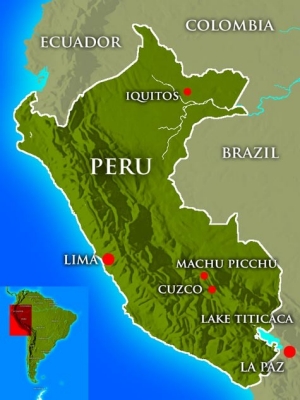
Upcoming Museum of the Earth Sciences Lectures:
October 1, 2013:
Turning Dessert into Garden by Tunneling through the Andes - Geological Challenges of the Olmos Project, Peru
Speaker: Dr. Brendan Fisher, FSR Engineering
7pm, Hurlburt Student Center Auditorium
Picture credit: http://nearshoreamericas.com/wp-content/uploads/2010/04/peru_map_011.jpg
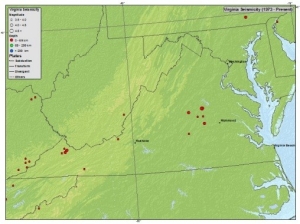
November 12, 2013
Earthquakes in Virginia
Speaker: Dr. Chuck Bailey, College of William and Mary
7pm, Hurlburt Student Center Auditorium
Picture credit: http://earthquake.usgs.gov/earthquakes/states/virginia/seismicity.php
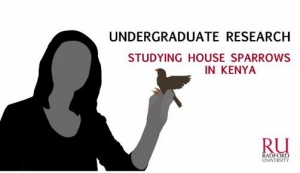
New Science In Action Undergraduate Research Video Highlights an International Experience
Laken Cooper, a senior majoring in biology, had the opportunity to travel to Kenya during summer 2013 to research house sparrows as an invasive species. Working alongside Radford University Assistant Professor of Biology, Dr. Sarah O’Brien, Laken had a graduate-level experience as an undergraduate. “She was our ‘right-hand woman’ throughout the process,” states Dr. O’Brien. “Laken had the opportunity for exposure to the global impact of science, but also some of the regulatory hurdles of working with international permits and governmental processes.”
In the video, Laken discusses the core of the research theory, studying the way that the sparrows adapt to survive in many different environments, but also the experience of international travel. Laken was supported in her effort by a grant from the Scholar Citizen Initiative. The SCI, which serves as a quality enhancement program across the curriculum for the entire University, is designed to help students find new ways to learn about communities around the world and to reflect on their experiences as a part of their education.
To learn more:
Laken’s Video: http://www.radford.edu/content/radfordcore/home/news/releases/2013/september/Science-In-Action.html
About the Scholar-Citizen Initiative: http://www.radford.edu/content/scholar-citizen/home.html
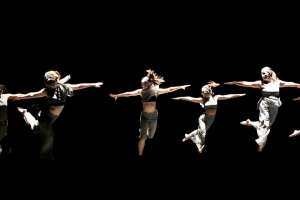
Jessica Wheeler photographed by Tom Hikaru Lim
Mathematics and Dance Student Completes Internship at the Oak Ridge National Laboratory
Jessica Wheeler loves figures, both in an equation and on the dance floor. As a double major in Applied Mathematics and Dance at Radford University, she has forged an unusual path and has had a number of unique experiences reflecting her many passions in life. During the summer 2013 break from classes, Jessica was able to feed another passion in Computer Science, during an internship at the Oak Ridge National Laboratory (ORNL) in Tennessee through a program sponsored by the Department of Energy.
Jessica learned of the program through a family friend and applied online through the Science Undergraduate Laboratory Internships program (SULI). While she was well-qualified for the program due to her academic experience, it was her support from a faculty member that sealed the deal. “The letter from my JAVA professor, Don Braffitt, was key to my getting selected for the internship” states Jessica. “His support was invaluable in the process.”
Once accepted into the program, Jessica thought she would be working with image interpretation, but soon found that she was being shown another opportunity. “My program was changed to computational science and engineering where I worked with Big Data projects aimed at lowering the cost of healthcare for all US citizens” recalls Jessica. “It was a much bigger experience than I had expected and really taught me what high-level research looks like.”
Jessica’s mentor in the program, Rangan Sukumar, who is a research scientist at the ORNL, selected her because she had such divergent interests and he felt she would bring a unique background to the project. When speaking about her mentor, Jessica said “He really helped me see the big picture of what we were doing and helped me prepare for the work we did.”
Growth for those engaged in the program was a significant goal for the ORNL. Being a multiprogram science and technology facility, the Oak Ridge National Laboratory works in many different areas and engages a large number of student interns from around the nation.
Throughout the course of the program, interns had opportunities for seminars and classes, “brown bag” lunch discussions and were expected to produce a deliverable at the end of their experience. “I helped prepare a poster, a paper and two abstracts and participated in a joint poster presentation with another member of my cohort, Frank Aline, a student from New York” said Jessica.
Following this experience, Jessica has returned to RU for her senior year and a busy schedule that not only includes her classes, but also involvement in CRU (Campus Crusade for Christ), Honors Academy, Harmony in Motion, and National Society of Collegiate Scholars. Following graduation, Jessica plans to further her mathematics education with a goal of landing a teaching position in a community college where she will have more time to pursue dance.
Learn more:
About Jessica: http://www.radford.edu/content/radfordcore/home/admissions/my-choice/jessica-wheeler.html
About SULI: http://science.energy.gov/wdts/suli/
About the Oak Ridge National Laboratory: http://www.ornl.gov/
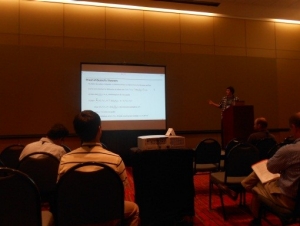
James Grenier delivering his presentation at MATHFEST 2013. Photo credit: John McGee
RU STUDENT PRESENTS RESEARCH PROJECT REGARDING BEZOUT’S THEOREM AT MATHFEST 2013 IN HARFORD, CONNECICUT
James Grenier, a RU Mathematics Major, was a recipient of a 2013 SURF (Student Undergraduate Research Fellowship) grant for the project “An Expository Proof of Bezout’s Theorem.” James and RU Mathematics Instructor, John McGee worked together nearly full-time during Summer II to tease out the details of the proof which made heavy use of commutative ring theory, as subject not often studied at the undergraduate level.
The result was about 40 pages of detailed typeset mathematics. James summarized his work in a 20 minute talk at MATHFEST 2013, in Hartford, CT. He also presented his work at a poster session at the same conference in August.
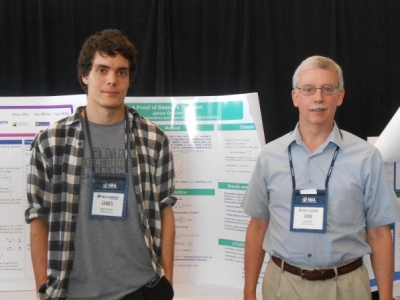
James Grenier and John McGee
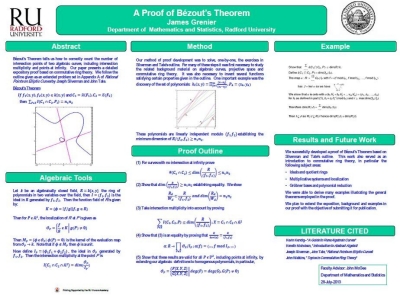
Radford University Student Explores 14 Million Year Old Whale Fossils Near Richmond Virginia
Rose Neikirk, an RU senior majoring in biology with a double minor in geology and chemistry, was offered the opportunity to intern at the Virginia Museum of Natural History last semester. She was told that the position would be open for most of the summer and that she could set her own time frame.
“I decided to go for about 2 months, give or take a week or a weekend at home here and there: recalls Rose. “The museum is located in Martinsville Virginia, which is about two hours from home, so I had to leave my home, family, and everything familiar but it seemed like a great opportunity. I toured the museum and was impressed with the collections and with the knowledge of the man that I would be working with.”
While at the museum, Rose got a taste of a lot of the odd jobs that go along with paleontology. She was given a fossil to prepare, a broken, rotten radius and ulna from a whale that was about 14 million years old. Rose soon learned that some of the fossil would be softer than the sediment and she had to work very patiently to not gouge parts of the fossil. On other days, Rose worked on in other areas, such as de-fleshing: learning how to clean more recent skeletons; and molding and casting of fossils to make less fragile copies. Her experiences also extended to the field. “We went on an excavation for a day to a quarry that is famous for having tiny Jurassic bugs, and I was allowed to keep a couple of the fossils I found and also found several that the museum wanted” she said.
Within a few weeks of general experience, Rose decided upon a research project: to look at the vertebra of whales from Carmel Church Quarry near Richmond, Virginia. “These whales were about 14 million years old and I spent several weeks examining individual vertebra to see if there was evidence of scavenging” Rose remembers. “Once I had examined more than 300 bones I wrote a paper comparing my findings to another, similar quarry in California, called Sharktooth Hill. I was able to show that Carmel Church has a good deal more evidence of scavengers than Sharktooth Hill.” The evidence uncovered help paleontologists understand the ecosystem that evolved in that area utilizing the whale carcass.
“I chose to take this internship because I am interested in being a paleontologist and this seemed like the perfect opportunity” states Rose. “I enjoyed the work, and I learned a lot of new things. The insight into the life of a paleontologist was probably the most valuable part of my experience. I was able to observe how a paleontologist lives both at work and at home which gave me a lot to think about for my future and where I want to go.”
Rose also remembers the additional benefits of the experience. “I was lucky enough to be able to turn this into an independent study that earned me 6 credits that I can use for my geology minor and biology major.” She concludes “The entire experience was very rewarding and gave me a lot of perspective on a lot of aspects since I lived with some of my coworkers.”
College of Science and Technology Career Updates
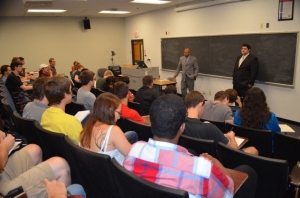
Representatives from Multivision, Inc and CGI visit Radford University
On Monday, September 16, David Gaines and Joe Gates from Multivision, Inc. participated in information and recruiting sessions.
RU Students interested in Information Technology careers gathered in Davis Hall 151 and the lounge area of Stuart Hall to learn more about opportunities in the current job market. Mr. Gaines spoke frankly with the group about preparing for interviews and learning how to sell themselves to prospective employers.
The company has hired a number of RU graduates and is looking to increase the Highlander presence on their team. We will post additional notices when Multivision returns to campus later this academic year.
Multivision Inc. is one of the fastest growing information technology (IT) solutions provider and a recognized authority in innovative workforce development training.
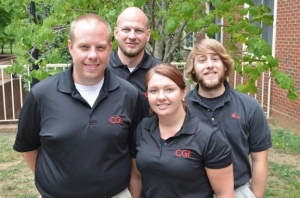
On Wednesday, September 18, representatives from CGI met with students in Davis 151 and Stuart Hall lounge to discuss career opportunities. With over 69,000 employees world-wide, CGI provides end-to-end IT and business process services that facilitate the ongoing evolution of businesses needs ranging from cyber security to cloud services. CGI recruits internationally and has offices world-wide, including the Lebanon, Virginia home base of the visitors to campus that day.
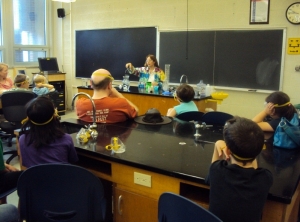
Dr. Kimberly Lane, Assistant Professor of Chemistry at Radford University, demonstrates the "magic" of science.
Science Days Provide Support to Local Educators
Each year, Radford University faculty and students host hundreds of K-12 school groups for “Science Days” as a day-long field trip full of science activities on campus. Children have the opportunity to learn more about science through programs at the RU Planetarium, the Geology Department's Museum of the Earth Sciences, the Biology Department's Greenhouse, the Chemistry Department “magic show” and demonstrations from the Physics Department. The first Science Day for 2013-2014 was held on September 12.
Learn more: http://www.radford.edu/sciencedays
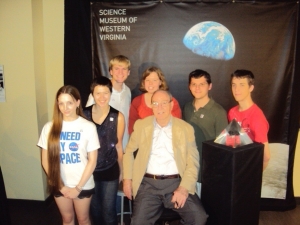
Members of the RU CSAT STEM club and Society of Physics Students with Dr. Edgar Mitchell
Radford University College of Science and Technology Club and Organization Activities
RU Students meet Astronaut Dr. Edgar Mitchell
On Saturday, September 21, 2013, members of the RU CSAT STEM club and the Society of Physics Students traveled to the Science Museum of Western Virginia in Roanoke for a special program with the sixth man to ever walk on the Moon, Dr. Edgar Mitchell. Not only did the students have the opportunity to hear an hour-long presentation from Dr. Mitchell detailing his journey from his early life on his family farm all the way to the Moon, but they also had the opportunity to meet him for a photo. The presentation, which included exclusive pictures from Dr. Mitchell’s personal collection, revealed the hardships of even attempting a lunar mission, not to mention the actual hurdles encountered upon landing. As a member of the Apollo 14 mission in 1971, Dr. Mitchell helped conduct some of the first science experiments on the moon, some of which are still utilized by astronomers today.
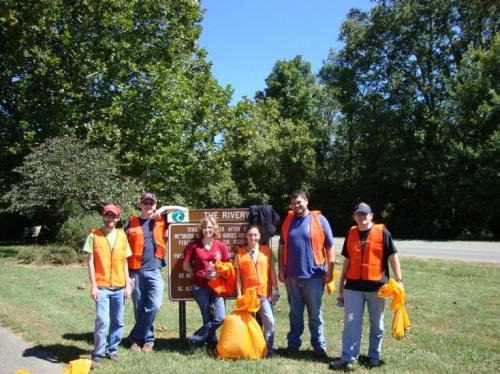
The Radford University Geological Society held a clean-up day along the shore of the New River in Radford’s Bisset Park on Saturday, September 14 as a part of the RU Service and Sustainability week.
Anthropology Lunchtime Lecture Series Presents:
“Domestication of the Dog”
by Dr. Darcy Morey
All lectures will be held in Whitt Hall 108 Friday @ noon
Do you love your dog? Have you ever wondered how the domestication of man’s best friend developed? Join Dr. Morey every Friday at noon to discuss the domestication of the dog. Bring your lunch, bring a friend, but sadly, leave your pup at home.
10/4/13: Ancestry and the Earliest dog
10/11/13: The Process of Domestication
10/18/13: Late Prehistoric Dogs of the North American Artic
10/25/13: Ancient Dog Burials Worldwide
11/01/13: Why Dogs and People Relate So Well
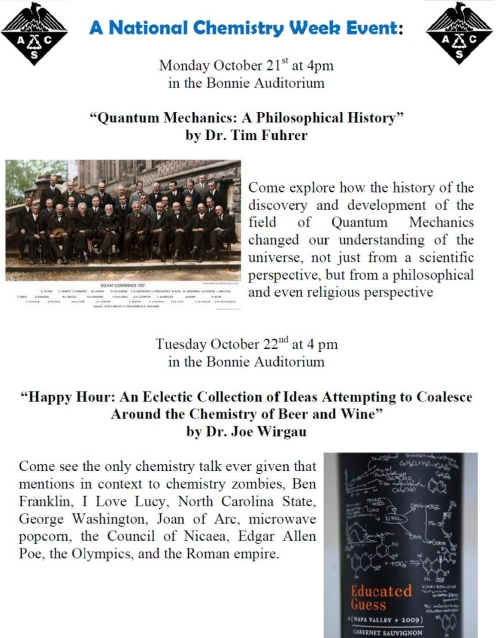
National Chemistry Week
October 20-26, 2013
Please mark your calendars! More details coming soon!